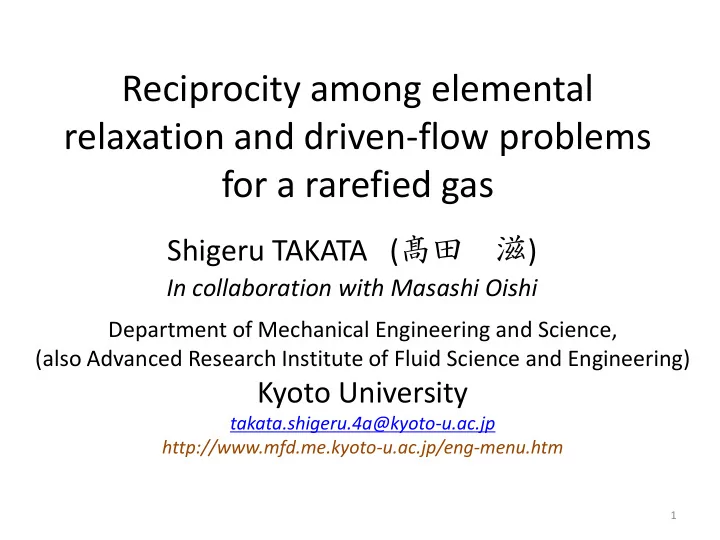

Reciprocity among elemental relaxation and driven-flow problems for a rarefied gas Shigeru TAKATA ( 髙田 滋 ) In collaboration with Masashi Oishi Department of Mechanical Engineering and Science, (also Advanced Research Institute of Fluid Science and Engineering) Kyoto University takata.shigeru.4a@kyoto-u.ac.jp http://www.mfd.me.kyoto-u.ac.jp/eng-menu.htm 1
Motivation: Fluid-dynamical and thermal phenomena are mutually inductive in rarefied gases. Example 1: Steady flow mass flux heat flux Poiseuille flow Thermal transpiration heat flux mass flux identity e.g. Loyalka (1971) Onsager reciprocity 2
e.g. Example 2: steady flow Roldughin (1994) (slow) uniform flow identity Non-uniform A force acting on temperature the particle field is induced. Thermal polarization Thermophoresis What kind of relations (or identities) does hold, in general , between two problems described by the linearized Boltzmann equation? 3
Our recent theory • Steady case – T. (2009) J. Stat. Phys (symmetry argument) – T. (2009) J. Stat. Phys (relation to Onsager’s reciprocity) (cf) for entropy production, Onsager’s reciprocity Waldmann, Kuscer, Roldughin , Loyalka, … • Unsteady case – T. (2010) J. Stat. Phys. TODAY : Numerical demonstration of a simple example 4
Problem: Rarefied gas flows in a channel time dependent (DP) (DT) D D gravity (0,- g ,0) (RP) (RT) Initial state Initial state D D Uniform flow (0, U ,0) Uniform heat flow (0, q ,0) 5
Problem: Rarefied gas flows in a channel Basic assumption Boltzmann equation kinetic boundary condition (with the detailed balance) linearization (weakly perturbed system ) around a reference resting equilibrium state Numerical computation Bhatnagar-Gross-Krook model (Boltzmann-Krook-Welander model) diffuse reflection boundary condition 6
Dimensionless formulation 1 7 (Kn: Knudsen number)
(DP) (DT) Temperature gradient gravity Temperature gradient (RP) (RT) Initial state Initial state Uniform flow Uniform heat flow 8
Reciprocity of fluxes
Symmetric relation (time-dependent) Time-dependent linearized Boltzmann equation b.c. i.c. T (2010) J. Stat. Phys Symmetric relation : convolution 10
Apply the symmetric relation for unsteady problems T (2010) J. Stat. Phys [NOTE] For any t and any k 3! = 6 identities 11
Dimensionless mass flow Dimensionless heat flow (DP) (DT) Temperature gradient gravity Temperature gradient (RP) (RT) Initial state Initial state Uniform flow Uniform heat flow 12
Numerical results
Numerical results 1. Flux reciprocity
Dimensionless mass flow Dimensionless heat flow (DP) (DT) Temperature gradient gravity Temperature gradient k = 1 Initial state Initial state (RP) (RT) Uniform flow Uniform heat flow 15
Dimensionless mass flow k = 1 Dimensionless heat flow (DP) (DT) Temperature gradient gravity Temperature gradient Initial state Initial state (RP) (RT) Uniform flow Uniform heat flow 16
Dimensionless mass flow k = 1 Dimensionless heat flow (DP) gravity Initial state (RP) Uniform flow 17
Dimensionless mass flow k = 1 Dimensionless heat flow (DT) Temperature gradient Temperature gradient Initial state (RT) Uniform heat flow 18
Numerical results 2. Velocity distribution function
(DP) (DT) Temperature gradient gravity Temperature gradient (RP) (RT) Initial state Initial state Uniform flow Uniform heat flow 20
Discontinuities propagate into a gas along the characteristic lines Sugimoto & Sone (1990) (RP) (RT) Initial state Initial state Uniform flow Uniform heat flow 21
(DP) (DT) Temperature gradient gravity Temperature gradient No discontinuities 22
Marginal VDF k = 1, x 1 =0.3965 Propagation of discontinuities (RP) Initial state Uniform flow
Marginal VDF k = 1, x 1 =0.3965 (DP) gravity
Marginal VDF k = 1, x 1 =0.3965 (DP) gravity No discontinuity (BUT) Propagation of derivative discontinuities
Relaxation problems vs driven-flow problems Relaxation Problems 1. discontinuity g : 2. Identity should hold at the level of profile Driven-flow Problems derivative discontinuity 26
(DP) (DT) Temperature gradient gravity Temperature gradient Time integral (RP) (RT) Initial state Initial state Uniform flow Uniform heat flow 27
Dimensionless mass flow Dimensionless heat flow k = 1 (DT) Temperature gradient Temperature gradient (RT) Initial state Uniform heat flow 28
Dimensionless mass flow Dimensionless heat flow (DP) gravity (RP) Initial state Uniform flow k = 1 29
Summary • Linearized Boltzmann Eq. (rarefied gases) • Reciprocity among – Relaxations from uniform mass (RP) and heat flows (RT) – Gravity-driven (DP) and temperature-driven (DT) flows • Numerical demonstration (BGK+diffuse reflection) – Identities among the fluxes – Discontinuity of VDF in (RP) and (RT) – Derivative discontinuity of VDF in (DP) and (DT) – (DP) and (DT) = Time integral of (RP) and (RT) 30
Recommend
More recommend